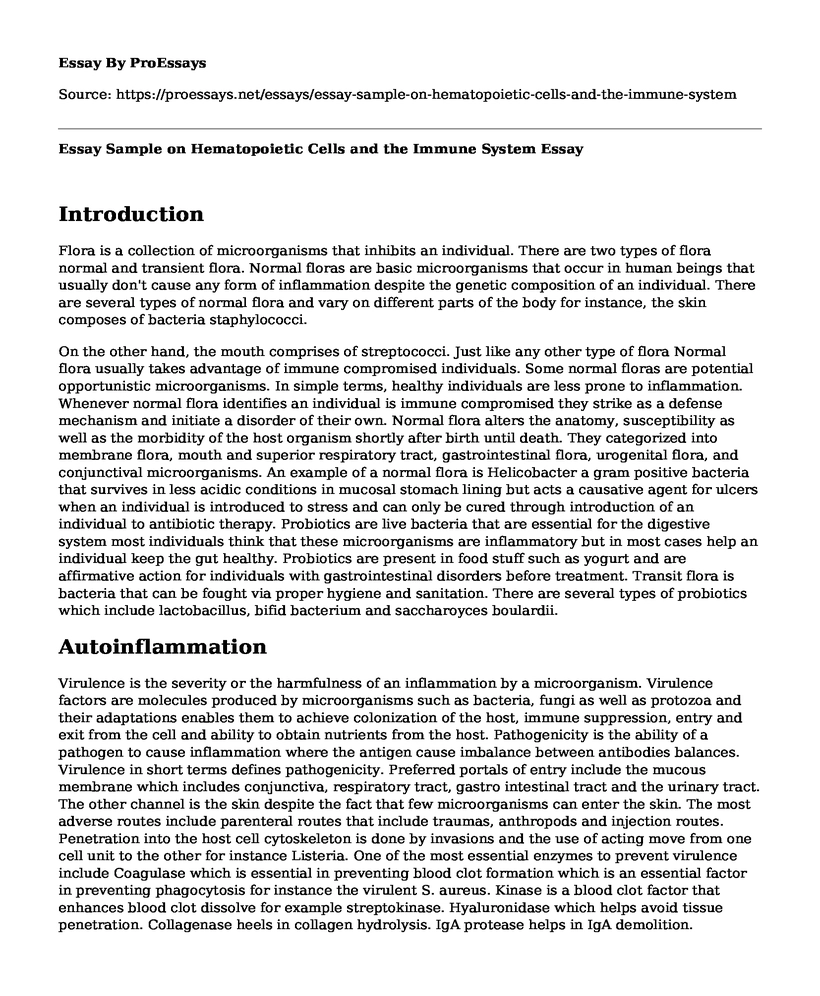Introduction
Flora is a collection of microorganisms that inhibits an individual. There are two types of flora normal and transient flora. Normal floras are basic microorganisms that occur in human beings that usually don't cause any form of inflammation despite the genetic composition of an individual. There are several types of normal flora and vary on different parts of the body for instance, the skin composes of bacteria staphylococci.
On the other hand, the mouth comprises of streptococci. Just like any other type of flora Normal flora usually takes advantage of immune compromised individuals. Some normal floras are potential opportunistic microorganisms. In simple terms, healthy individuals are less prone to inflammation. Whenever normal flora identifies an individual is immune compromised they strike as a defense mechanism and initiate a disorder of their own. Normal flora alters the anatomy, susceptibility as well as the morbidity of the host organism shortly after birth until death. They categorized into membrane flora, mouth and superior respiratory tract, gastrointestinal flora, urogenital flora, and conjunctival microorganisms. An example of a normal flora is Helicobacter a gram positive bacteria that survives in less acidic conditions in mucosal stomach lining but acts a causative agent for ulcers when an individual is introduced to stress and can only be cured through introduction of an individual to antibiotic therapy. Probiotics are live bacteria that are essential for the digestive system most individuals think that these microorganisms are inflammatory but in most cases help an individual keep the gut healthy. Probiotics are present in food stuff such as yogurt and are affirmative action for individuals with gastrointestinal disorders before treatment. Transit flora is bacteria that can be fought via proper hygiene and sanitation. There are several types of probiotics which include lactobacillus, bifid bacterium and saccharoyces boulardii.
Autoinflammation
Virulence is the severity or the harmfulness of an inflammation by a microorganism. Virulence factors are molecules produced by microorganisms such as bacteria, fungi as well as protozoa and their adaptations enables them to achieve colonization of the host, immune suppression, entry and exit from the cell and ability to obtain nutrients from the host. Pathogenicity is the ability of a pathogen to cause inflammation where the antigen cause imbalance between antibodies balances. Virulence in short terms defines pathogenicity. Preferred portals of entry include the mucous membrane which includes conjunctiva, respiratory tract, gastro intestinal tract and the urinary tract. The other channel is the skin despite the fact that few microorganisms can enter the skin. The most adverse routes include parenteral routes that include traumas, anthropods and injection routes. Penetration into the host cell cytoskeleton is done by invasions and the use of acting move from one cell unit to the other for instance Listeria. One of the most essential enzymes to prevent virulence include Coagulase which is essential in preventing blood clot formation which is an essential factor in preventing phagocytosis for instance the virulent S. aureus. Kinase is a blood clot factor that enhances blood clot dissolve for example streptokinase. Hyaluronidase which helps avoid tissue penetration. Collagenase heels in collagen hydrolysis. IgA protease helps in IgA demolition. Exotoxins are proteins produced by inflammatory bacterias especially gram affirmative bacteria as a part of their metabolism as well as growth. Exotoxins are extracted into the environment after intermediate lysis.
On the other hand, endotoxins are lipid segments of LPSs mostly manifested by gram harmful bacteria. Endotoxins are prevalent when bacteria die or when the cell wall disintegrates. A biofilm consists of an assemblage of microorganism where cells stick together especially on the surface. The biggest challenge is that biofilms form on living as well as nonliving structures. Biofims in most organism manifest as dental plaque where in most instances they cause tooth decay as well as gum diseases. Quorum sensing is the procedure or the device mechanism in which bacteria use to restrict gene regulation regarding the population by instituting signal molecules.
Cite this page
Essay Sample on Hematopoietic Cells and the Immune System. (2022, Nov 05). Retrieved from https://proessays.net/essays/essay-sample-on-hematopoietic-cells-and-the-immune-system
If you are the original author of this essay and no longer wish to have it published on the ProEssays website, please click below to request its removal:
- Influenza Vaccine and Herd Immunity - Essay Example on Public Health
- Definitions and Issue of Incivility in Nursing - Research Paper
- Paper Example on Evidence-Based Practice in Clinical Decision Making
- Critical Differences Between DPN and PhD or DNS Programs Paper Example
- Essay Example on Oxygen: Essential for Human Survival & Health
- Paper Example on COPD: Symptoms, Diagnosis, and Treatment
- Essay on Understanding and Preventing Lyme Disease: Insights into Vector-Borne Pathogens







